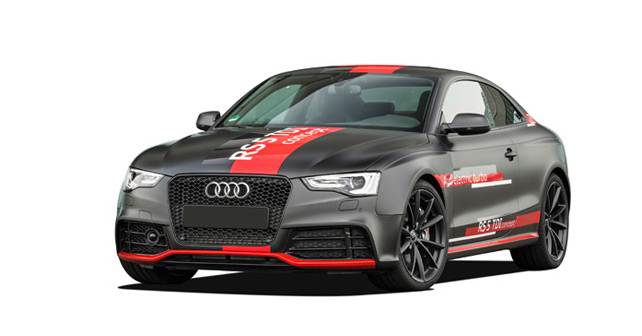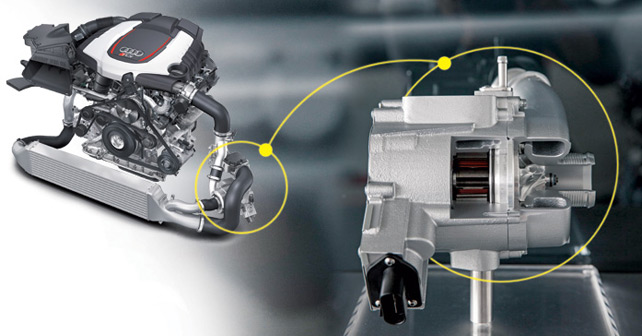Audi has developed the first diesel engine with an electric turbocharger. And while it won’t be formally launched for another two years, the engine’s specs are truly pioneering. Here’s how it works.
According to a study by the German car manufacturers association, the VDA, fifteen years from now, 80% of the vehicles on the road will still be equipped with internal combustion engines. These forecasts, and the dire need to reduce CO2 emissions, are pushing car manufacturers to evolve the traditional internal combustion engine and to experiment with next generation technologies. One shining example of these efforts can be found at Audi – specifically in the form of the upcoming Audi A6 3.0 TDI (producing 326bhp with a single electric turbo) and the RS 5 TDI (producing 385bhp with twin electric turbos). Of course, this isn’t the first time that we’ve seen electric turbo powered engines. But these two Audi prototypes could see the light of day within the next two years.
Instantaneous response
In addition to the traditional turbo driven by exhaust gases, it has an electric motor with 7.4kW of power that’s capable of bringing the impeller of the turbo to its maximum revolutions of 70,000rpm in just 250 milliseconds. At low rpm for the combustion engine – and, consequently, with the exhaust gasses at low pressure – a bypass valve is placed after the intercooler that directs air to the electric compressor, which is directly connected to the power supply. When the exhaust gases reach a high enough pressure, the conventional turbochargers jump into action – either one or two, depending on which of the two Audi prototypes you’re dealing with.
The advantages
The most obvious result of this technology is the immediate response from the engine – right from idle. Another practical example is that this electric turbo engine allows the driver to be lighter on the throttle, which of course leads to a reduction in fuel consumption and CO2 emissions.
This technology is very flexible and leaves a number of additional innovations open to exploitation. The first of which is a dramatic increase in the usability of an engine, especially one with a lesser number of cylinders – enabling it to achieve higher outputs and be easily adapted to a larger range of applications.
It’s no coincidence, in fact, that Audi have tried to break the taboo by putting a turbo diesel under the hood of an RS model – a moniker synonymous with petrol-powered sport models. And while the decision to put an electric turbo diesel in a production RS model hasn’t been finalized, it’s clear that this technology will only be offered in high-end models to begin with – largely due, of course, to the cost of the electric turbo system and the electric apparatus necessary for its operation.
Up to 48 volts
The electric turbo developed by Audi operates at 48 Volts. In the two prototypes, the transition from 12 to 48V is achieved by a DC-to-DC converter – a single point of contact between the two electrical systems of the vehicle. The energy is temporarily stored in a lithium-ion battery and then released whenever the intervention of the electric turbo is required. The battery and converter, of course, not only add cost but weight as well. However, the 48V electrical system is an essential component because it powers other more powerful devices in addition to the electric turbo. And that’s not all, the benefits of a system of this type, with a voltage four times higher than standard, are well known to car manufacturers – especially to those who produce large luxury cars. In the future, with the 48V electrical system, for example, it’ll be possible to power numerous devices – such as the power steering, the engine cooling and oil pumps, the air conditioning compressor, the electromechanical rear brakes and thermoelectric heating elements. In addition to this, since the increase of the voltage produces a lowering of the current, you could also use thinner and lighter cables. So, conceivably, switching to a 48V setup will even contribute to lower CO2 emissions.
Slated for 2016
Audi is ready to launch the electric turbo powered engine and, consequently, a network dedicated to on-board 48V electricity supply for some models within a period of two years. The car debuting this technology, in 2016, will likely be the all-new 3.0 V6 TDI SQ7 – the top-of-the-range turbo-diesel that will replace the V12 in the next generation Q7. And this isn’t exactly a random choice, given that this model is aimed at those with high disposable incomes who are more able than most to bear the expense of new and cutting-edge technology. The TDI SQ7 will be an exclusive model – after all, it brings new technology to the road and does so in line with the current need to downsize.
A DIESEL E-TRON
The powertrain of the Audi RS 5 TDI Concept consists of (1) a 3.0-litre, twin-turbo diesel V6 mated to (2) an eight-speed (torque converter) tiptronic automatic (3) and four-wheel drive (4) with a sport differential at the rear axle. Two exhaust gas turbochargers: (5) a smaller one, which operates at lower pressures, (6) the other slightly larger one activates at higher revs. This unusual RS is capped off with an (7) Active sound system – a device that adds a little bit of anger to the sound of this turbo engine. In this illustration, in front of the left front wheel, you can also see (8) the electric compressor, which comes into operation at very low rpm, and (9) the bypass valve that manages the flow of air towards the engine according to the load. Audi firmly believes in the future of the diesel engine, which is considered the most efficient amongst the current internal combustion engines. It’s also perfectly suited to being electrified. By the end of the year, in fact, we’ll see the Q7 3.0 TDI V6 e-tron – the all-new sport utility with a diesel plug-in hybrid propulsion unit. This model is credited with a range of 50 kilometres in electric mode, with a power of 375bhp and a maximum torque of 700Nm.
© Riproduzione riservata
























Write your Comment